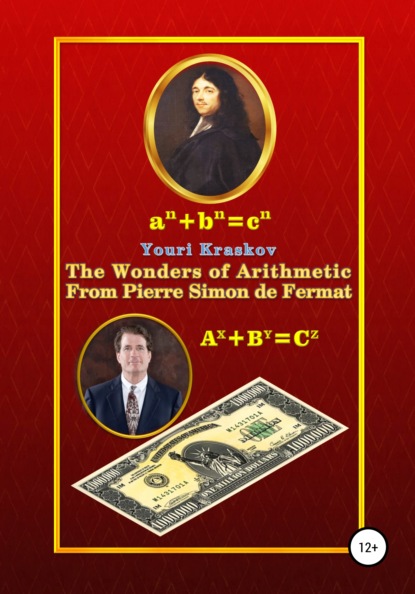По всем вопросам обращайтесь на: info@litportal.ru
(©) 2003-2024.
✖
The Wonders of Arithmetic from Pierre Simon de Fermat
Год написания книги
2021
Настройки чтения
Размер шрифта
Высота строк
Поля
?z
=243
m
=2; z
=1
We will not reveal all nuances of this method, otherwise all interest to this problem would have been lost. We only note that in comparison with Wallis method where the descent method is not used, here it is present in an explicit form. This is expressed in the fact that if the numbers m and z satisfying the equation 61m
–z
=1 exist, then there must still exist numbers m
<m and z
<z satisfying the equation 61m
–z
=3, as well as the numbers m
<m
and z
<z
, from equation 61m
–z
=9, etc. up to the minimum values m
<m
and z
<z
. The number 3 appearing in the descent is calculated as 64 – 61, that is, as the difference between 61 and the square closest to it. Calculations as well as in the Wallis method are carried out in the reverse order i.e. only after the minimum values of m
and z
have been calculated. As a result, we get:
m=3805; z=29718
x=2mz=2?3805?29718=226153980
y=?(61?2261539802+1)=1766319049
Of course, connoisseurs of the current theory will quickly notice in this example that the results of calculations obtained in it will exactly coincide with those that can be obtained by the Wallis' method. However, for this they will have to use the irrational number ?61, and our example with Fermat's method showed that it is possible to do calculations exclusively in the framework of arithmetic i.e. only in natural numbers. There is no doubt also that experts without much effort will guess how to get the formulas shown in our example. However, it will not be easily for them to explain how to apply this Fermat's method in the general case because from our example it is not at all clear how it is possible to determine that the ultimate goal is to solve the equation 61m
– z
= 243 from which calculations should be performed with a countdown.
It would be simply excellent if today's science could explain Fermat's method in every detail, but even the ghostly hopes for this are not yet visible. It would be more realistic to expect that attempts will be made to refute this example as demonstration a method of solving the problem unknown to science. Nevertheless, science will have to reckon with the fact that this example is still the only one in history (!!!) confirmation of what Fermat said in his letter-testament. When this secret is fully revealed, then all skeptics will be put to shame and they will have no choice, but to recognize Fermat as greater than all the other greatest scientists because they were recognized as such mainly because they created theories so difficult for normal people to understand that they could only cause immense horror among students who now have to take the rap for such a science.[43 - Examples are in many videos from the Internet. However, these examples in no way detract from the merits of professors who know their job perfectly.]
https://www.youtube.com/watch?v=wFz8W2HsjfQ (https://www.youtube.com/watch?v=wFz8W2HsjfQ)
https://www.youtube.com/watch?v=cUytn2SZ1n4 (https://www.youtube.com/watch?v=cUytn2SZ1n4)
https://www.youtube.com/watch?v=ZhVNOgaBStY (https://www.youtube.com/watch?v=ZhVNOgaBStY)
In this sense, the following example of solving a problem using the descent method will be particularly interesting because it was proposed in a letter from Fermat to Mersenne at the end of 1636, i.e. the age of this task is almost four centuries! Euler's proof [8] was incorrect due to the use of "complex numbers" in it. However, even the revised version of Andrе Weil in 1983 [17] is too complex for schooling.
3.4.4. Fermat’s Problem with Age 385 years
In the original version in 1636 this task was formulated as follows:
Find two square-squares, which sum is equal to a square-square,
or two cubes, which sum is a cube.
This formulation was used by Fermat's opponents as the fact that Fermat had no proof of the FLT and limited himself to only these two special cases. However, the very name "The Fermat’s Last Theorem" appeared only after the publication of "Arithmetic" by Diophantus with Fermat's remarks in 1670 i.e. five years after his death. So, there is no any reason to assert that Fermat announced the FLT in 1637.
The first case for the fourth power we have presented in detail in Appendix II. As for the case for the third power, Fermat's own proof method restored by us below, will not leave any chances to the solutions of this problem of Euler and Weil to remain in history of science, since from the point of view of the simplicity and elegance of the author's solution this problem, they will become just unnecessary.
Now then, to prove that there are no two cubes whose sum is a cube, we use the simplest approach based on divisibility of numbers, what means that in the original equation
a
+b
= c
(1)
the numbers a, b, and c can be considered as coprime ones, i.e. they do not have common factors, but in general case this is not necessary, since if we prove that equation (1) cannot have solutions in any integers, including those with common factors, then we will prove that coprime numbers also cannot be solutions of the original equation. Then we assume that both sides of equation (1) in all cases must be divisible by the number c
, then equation (1) can be represented as
c
= c





